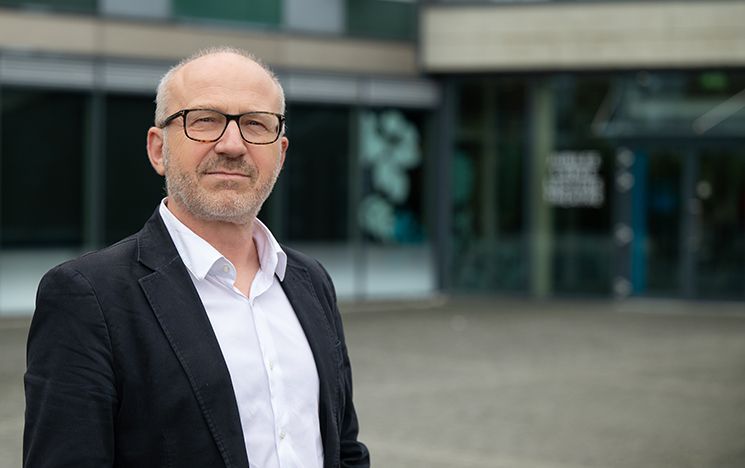Innovative infrastructure
Out with the old, in with renew

Cities are major polluters. Instead of demolishing and rebuilding, we need to enhance and retrofit our existing structures for a greener future. Professor Andrew Davies has this year won the Project Management Institute (PMI) Research Achievement Award for his lifelong research. The RM Phillips Freeman Chair and Professor of Innovation Management tells us about his most recent work innovating city infrastructure.
Why is infrastructure innovation in cities an important issue?
Cities produce over 70% of global CO2 emissions. So how cities – their buildings, roads, parks, transport, waste and power – are designed and built matters for a low-carbon future.
So many things have to change in a coordinated way to create ecologically sustainable and liveable cities, and that’s where we need innovation. No single organisation can do it by themselves. Mayors and people in city governments have often led the way in responding to the climate emergency and transitioning to net zero. Yet people in real estate, construction, housing associations and local planning departments have their own priorities, timelines and traditional ways of doing projects.
Accelerating the transition to net zero requires organisations with the capabilities in project management to orchestrate all of these people, and the ability to create innovative solutions using solar, wind and other sources of renewable energy.
What inspired your work on sustainability?
In 2010, I was invited to study the world’s first zero-carbon "ecocity" project in China with the engineering company, Arup. The work unlocked my passion to apply the innovation research I’d been doing to reduce carbon emissions in infrastructure and tackle the climate emergency.
If we think of our ageing and emission-heavy homes and commercial buildings in London, it’s quite easy to knock them down and build something new. Retrofitting – adapting older buildings to make them more energy efficient with modern insulation and energy sources – is complicated. But the opportunities for emission reductions by retrofitting are enormous, which is why it has become one of my research focus areas.
What issues are UK cities facing?
Cities of the future have to be increasingly sustainable to tackle climate change and rapid urban growth, while being resilient and inclusive. There are 3.8 million homes in London, which contribute around one-third of the city’s greenhouse gas emissions and are among the least energy-efficient in England. We don’t need to get rid of this housing – people need somewhere to live – but we do have to find a way of making it more fuel efficient, both for the environment and to tackle the cost of living crisis.
What role does innovation play in cleaning up city infrastructure?
While new, flashy infrastructure projects may seem exciting for our cities, the most sustainable solution often lies in innovating to improve what we already have.
There are a lot of new technologies that people think will solve our global climate emergency. I’ve looked at novel, exciting energy technologies – such as small modular reactors and nuclear fusion – that could be game-changers in tackling our constantly increasing temperatures. I’m all for us investing in big technological breakthroughs. But it could take as long as 30 years for this sort of new technology to start paying off.
When it comes to cities, there isn’t time to wait: we have to innovate now. I believe that we already have many of the technologies needed to generate, store and transmit energy from wind, solar and other renewable sources. Performance is improving all the time and costs are going down. We just have to start delivering.
Can you give an example of an innovation that is making urban areas more sustainable?
The Mayor of London launched a programme in 2020 to transform London’s existing housing stock into warm, affordable, and low-carbon homes while addressing urgent climate and social challenges. Our role on this programme involved research showing how innovative whole-house retrofits for housing association homes were being introduced in seven London boroughs. “Whole-house” means preparing an existing house for insulation and different sources of heating, like heat pumps or solar panels, all at once, rather than bit by bit, which can be wasteful, costly and time-consuming. By capturing this work, we were helping to scale up these approaches to help make more buildings more sustainable in more places.
Cost – and who pays – is surely a challenge for retrofitting?
On this project, finding a way of retrofitting cheaply to make it acceptable to the residents, housing associations, boroughs and construction companies was part of the challenge. It was going to mean changing the construction industry’s ways of working. They were going to have to make their approaches more flexible, and produce solutions in factories at lower cost. Plus, they would have to structure payments to make them affordable to the multiple groups. This was going to be challenging – residents and housing associations would share the costs and pay over time rather than upfront.
The “collaboration hub”, set up to stimulate innovation and bring everyone together, has made the retrofitting project possible. And, as well as the environmental benefits, residents have benefitted through lower fuel bills. In addition, by involving them in designing the approach, the work has contributed towards an enhanced sense of ownership and social cohesion in local communities.
What’s next for cities?
For cities to achieve the grand challenge of transitioning to net zero, we need all of the parties involved to find new ways of working collaboratively in multiple projects.
Innovation isn’t always about new technology, exciting start-ups or world-leading high-tech companies. It’s about implementing the systemic changes needed to introduce proven technologies in a local context, and then producing those at scale. Some of the winners of the PMI Award before me have recognised this, and I’m delighted to be able to share this accolade with them.